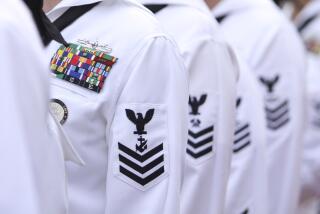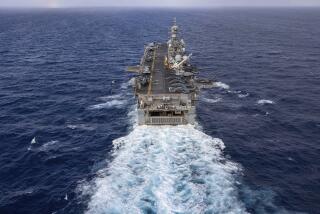Cole Probe Raises Security Questions
- Share via
WASHINGTON — When a bomb blasted a hole in the U.S. destroyer Cole last month, U.S. officials first portrayed the incident as a case of a well-guarded warship falling victim to the kind of calamities that are bound to occur when American forces patrol the dangerous Middle East.
In the weeks since, however, additional information has come to light on how well-protected the warship really was. Some evidence suggests that the ship’s company may not have followed all details of a security blueprint during the vessel’s refueling stop in Yemen. Other details have raised questions about the adequacy of Navy security procedures.
As a result, three weeks after the attack, which killed 17 U.S. sailors and injured 39, a different and more complex picture of the incident is emerging.
Though three official investigations are far from concluded, Navy officials acknowledge that they may find that the first successful terrorist attack on a modern U.S. warship caught the sailors off guard, despite the fleet’s elaborate preparations.
And they may decide that their challenge is not just to devise new security rules--as has happened after most major incidents--but also to make sure the fleet follows the rules it has.
“We’ve been drilling for this for a long time, but [a real attack] had never happened, and maybe it didn’t seem quite real,” said an officer on another ship who asked to remain unidentified because of the ongoing investigation. Now the Navy’s job will be to communicate that “it’s plenty real,” the officer said.
The military has had no lack of security rules in recent years, and officials stepped up that emphasis when 19 Americans died in a 1996 bombing of an Air Force barracks in Saudi Arabia.
Before the Cole, a $1-billion guided missile destroyer, could enter port in the Yemeni city of Aden, its officers were required to obtain the fleet commander’s written approval of a 61-question force-protection plan that was to spell out in detail such points as where sentries would be posted, and where the injured would be taken for medical help in the event of an attack.
Such plans are typically handled by junior officers, said one naval officer, but receive final approval from the top--in this case, the commander of the 5th Fleet, Vice Adm. Charles W. Moore, and the Cole’s skipper, Cmdr. Kirk Lippold.
In addition, the ship was supposed to comply with the rules of the Pentagon’s five-stage “Threatcon” security plan for terrorist attacks. The rules, devised by the Joint Chiefs of Staff and publicly available on the chiefs’ Pentagon Web site, call for more security precautions as the risk grows and rise from a “normal” condition through Threatcon Alpha, Bravo, Charlie and Delta.
When the Cole arrived in Aden, the port was under Threatcon Bravo. Though this is the second-lowest threat status, the ship was supposed to observe dozens of special measures.
These included identifying and inspecting port work boats, keeping unauthorized boats away from the ship, and making sure that even authorized craft were “controlled, surveilled and covered.”
At a hearing last month, Sen. Carl Levin (D-Mich.), ranking minority member of the Senate Armed Services Committee, waved a copy of the security rules to demonstrate to the families of the Cole casualties and others that the military had taken steps to ensure their safety.
But since the attack, several Cole sailors have said they believe that the crew took few special steps other than posting sentries with rifles on deck. The sailors apparently did not “inspect” harbor work boats that came to handle mooring lines and haul away the Cole’s garbage, if that meant boarding the small craft.
The Cole carried two small boats, one for the captain and one for the crew, that could be used for port security operations. But they weren’t lowered into the water for patrol duties during the refueling, officials said.
The Threatcon Bravo rules call for the ship to arrange to put small boats in the water on 15 minutes’ notice to patrol around the ship. But according to one Navy officer, this would not have been possible during the four to five hours scheduled for refueling because the boats had to be lowered from the starboard side, which was then blocked by the refueling barge.
The Navy originally said the terrorists’ boat was able to reach the Cole because it was part of a team of contract craft that helped with mooring lines. But on Oct. 20, officials backed off that account, saying the attacking boat didn’t help with the mooring and showed up about two hours later.
Based on what sailors have said, it now appears more likely that the attacking boat approached across the harbor from the west, in a way that should have attracted notice.
U.S. ships rely in part on local harbor authorities for security. In this case, Yemeni officials were apparently keeping most harbor traffic away from the immediate vicinity of the Cole.
But they apparently didn’t have patrol vessels around the ship that could have intercepted a small boat coming from across the harbor, said one congressional staff member. And that raises questions about whether the Navy relied too heavily on the local authorities, the aide said.
Navy officials said they could decide to step up their security in high-risk ports by patrolling the areas around ships with security teams, such as Navy SEALs, the U.S. Coast Guard or private contract firms. These teams could set up perimeters in harbors--made of booms, for example--to try to control the approach of small boats, some naval experts said.
Yet some Navy officers and former skippers predict that the Navy may find it difficult to get skippers to hew closely to the rules and get tough with small boats because of the high risk of a mistake.
The Navy’s rules give captains the prerogative to use deadly force if they are convinced that a boat represents a deadly threat. Many ships are equipped with .50-caliber machine guns that can stop small boats at hundreds of yards.
In practice, however, it is difficult to discern friend from foe, since an attacker will keep his guns and explosives out of sight.
Navy skippers recall the U.S. guided missile frigate Stark, which did not respond to the threat posed by an errant Iraqi aircraft in 1987 during the Iran-Iraq War. The Stark was struck by two Exocet missiles, which killed 37 crew members. Skippers also remember the lesson of the U.S. cruiser Vincennes, which shot down an Iranian jetliner in 1988, killing 290 people, in the mistaken belief that it was a threat.
Gordon McCormick, director of terrorism research at the Naval Postgraduate School at Monterey, said this growing pressure for vigilant security will put skippers in a difficult spot. Keeping track of the hundreds of small boats that may be bobbing in a harbor means “getting physical,” yet that risks mistakes with huge diplomatic ramifications.
“The Navy’s in a Catch-22,” he said.
More to Read
Sign up for Essential California
The most important California stories and recommendations in your inbox every morning.
You may occasionally receive promotional content from the Los Angeles Times.














